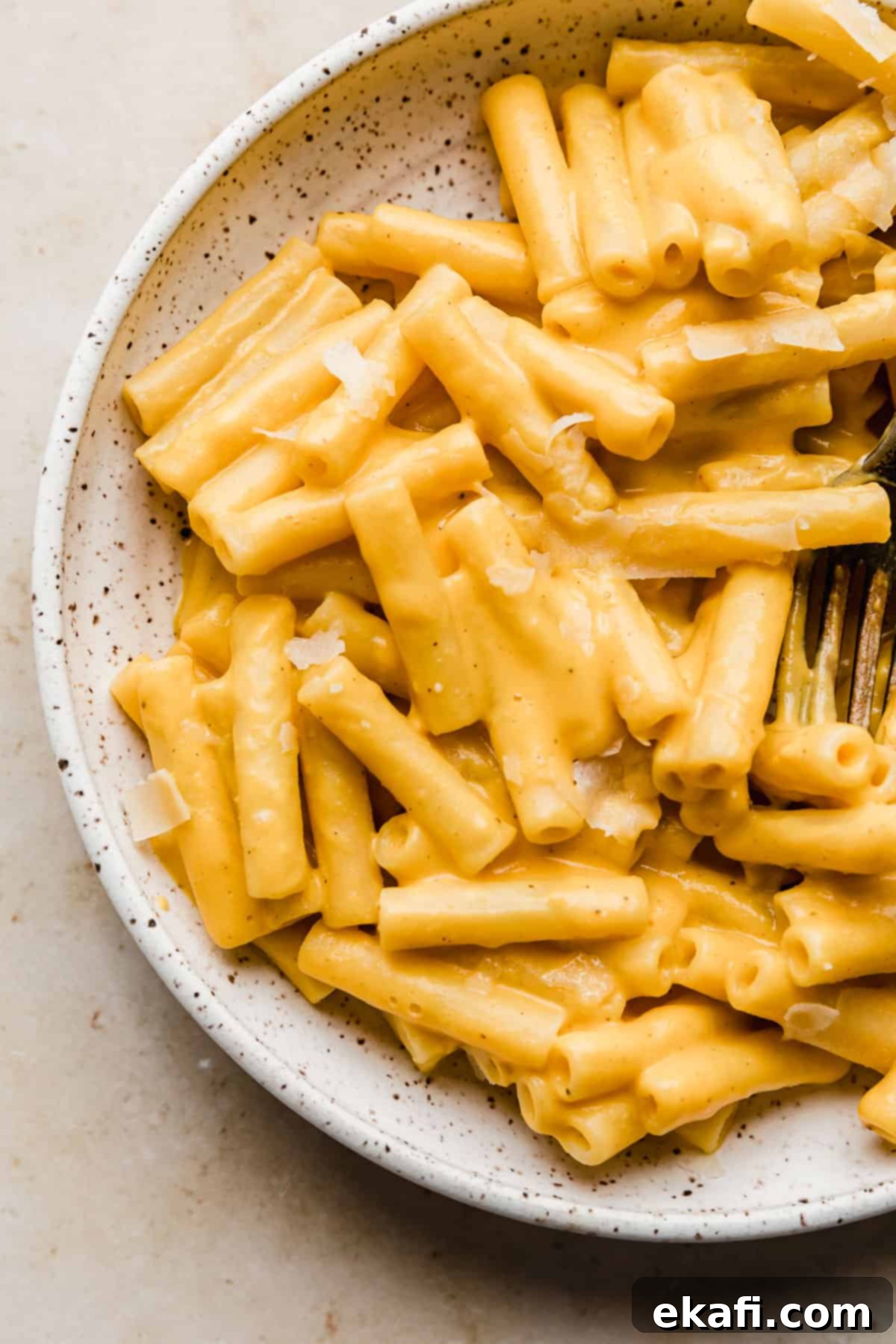Creamy Roasted Butternut Squash Pasta: An Easy & Flavorful Weeknight Meal
Prepare to fall in love with this incredibly creamy and flavorful butternut squash pasta recipe! Crafted with perfectly roasted butternut squash, rich half & half, and a hint of warm nutmeg, this dish delivers a thick, velvety sauce that’s both comforting and surprisingly easy to make. It’s the ideal meal for busy weeknights, offering a delicious way to enjoy the vibrant flavors of autumn and sneak in some wholesome vegetables.
I’ve always enjoyed experimenting with creative and delightful ways to incorporate butternut squash into my cooking. This versatile winter squash shines beautifully in pasta dishes, whether it’s in ravioli, orzo, or a decadent fettuccini alfredo. Beyond pasta, it’s also fantastic in savory side dishes like butternut squash and kale. My family and I are truly “nuts for butternut,” and I’m confident this recipe will make you one too!
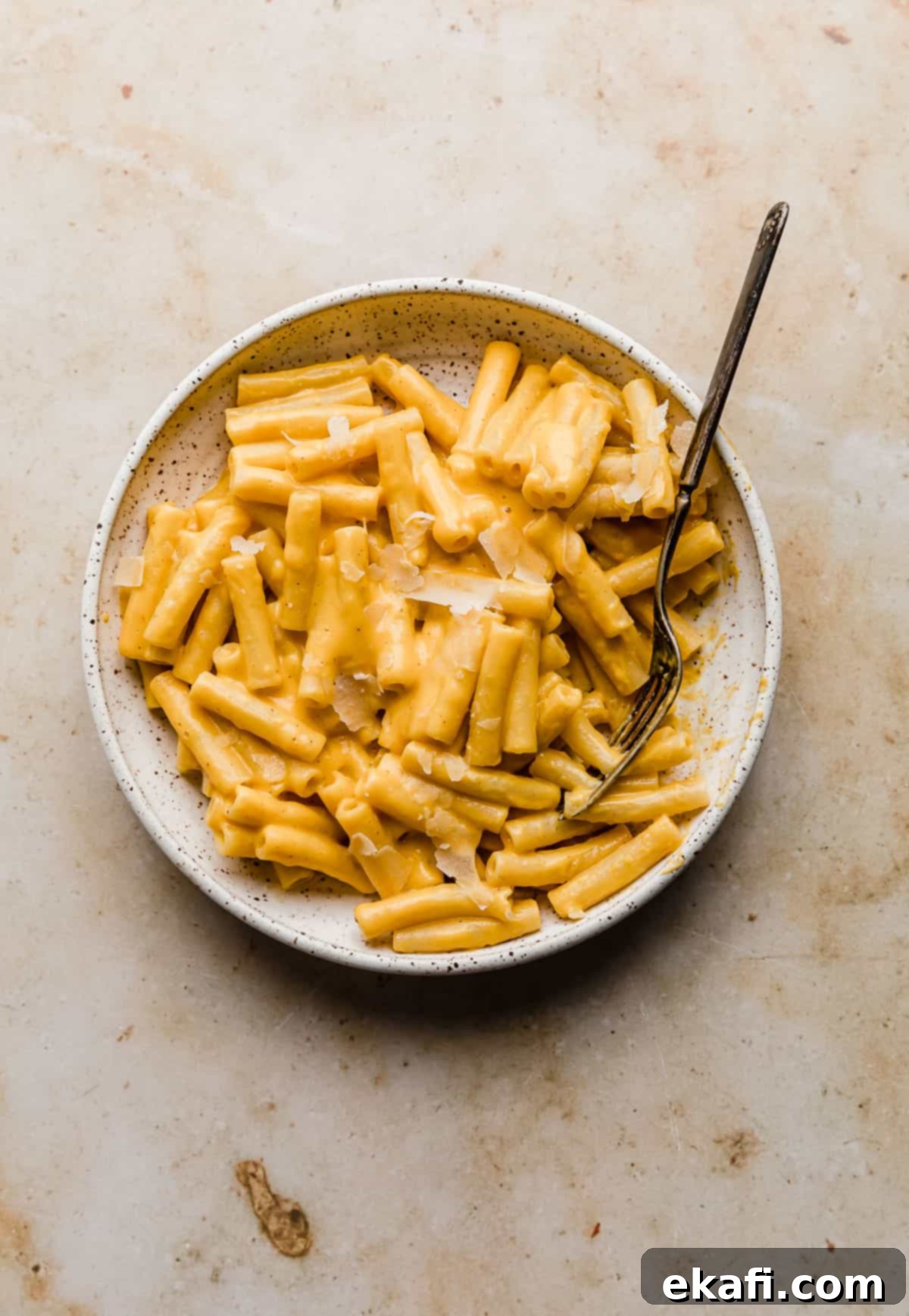
Why This Butternut Squash Pasta Recipe is a Must-Try
This creamy butternut squash pasta isn’t just another dish; it’s a culinary hack for delicious, nutritious, and convenient meals. Here’s why it deserves a permanent spot in your recipe rotation:
- Effortlessly Sneak in Vegetables: If your little ones, or even picky adults, have an undeniable love for plain pasta, this recipe is a game-changer. The roasted butternut squash blends seamlessly into a vibrant, creamy sauce that disguises its vegetable goodness. Kids get the comforting pasta they adore, while parents can rest assured they’re receiving essential vitamins and nutrients like potassium, Vitamin E, and Vitamin C. It’s a win-win for both taste buds and health!
- Simple Ingredients, Maximum Flavor: One of the best aspects of this dish is its reliance on minimal, readily available ingredients. You won’t need to scour specialty stores; just a few fresh components come together to create an impressive depth of flavor. This simplicity makes grocery shopping a breeze and cooking more enjoyable.
- A Quick 30-Minute Meal Solution: In today’s fast-paced world, finding delicious and unique meals that fit into a tight schedule is invaluable. This butternut squash pasta can be on your table in just about 30 minutes, making it perfect for busy weeknights. It’s different enough to excite the palate but familiar enough that even selective eaters will embrace it. It’s a smart addition to any meal plan, especially when you’re looking to diversify beyond your usual staples.
- Excellent for Utilizing Butternut Squash: Whether you bought a squash with no specific plan or have leftovers from another meal, this recipe is an ideal way to use it up. If you’ve already oven-roasted some squash for dinner the night before, simply scoop out the cooked flesh and add it to your blender. It’s a fantastic example of repurposing ingredients, reducing food waste, and transforming simple leftovers into a gourmet-style meal.
- Seasonal Comfort Food: Butternut squash is a quintessential fall and winter vegetable, and this recipe truly embodies the cozy, comforting spirit of these seasons. The warm, earthy notes of the squash, combined with a touch of nutmeg, create a dish that feels like a warm hug on a cool evening.
Detailed Ingredient Notes for the Perfect Butternut Squash Pasta
Understanding each ingredient’s role is key to mastering this creamy pasta. Here’s a closer look at what makes this recipe shine:
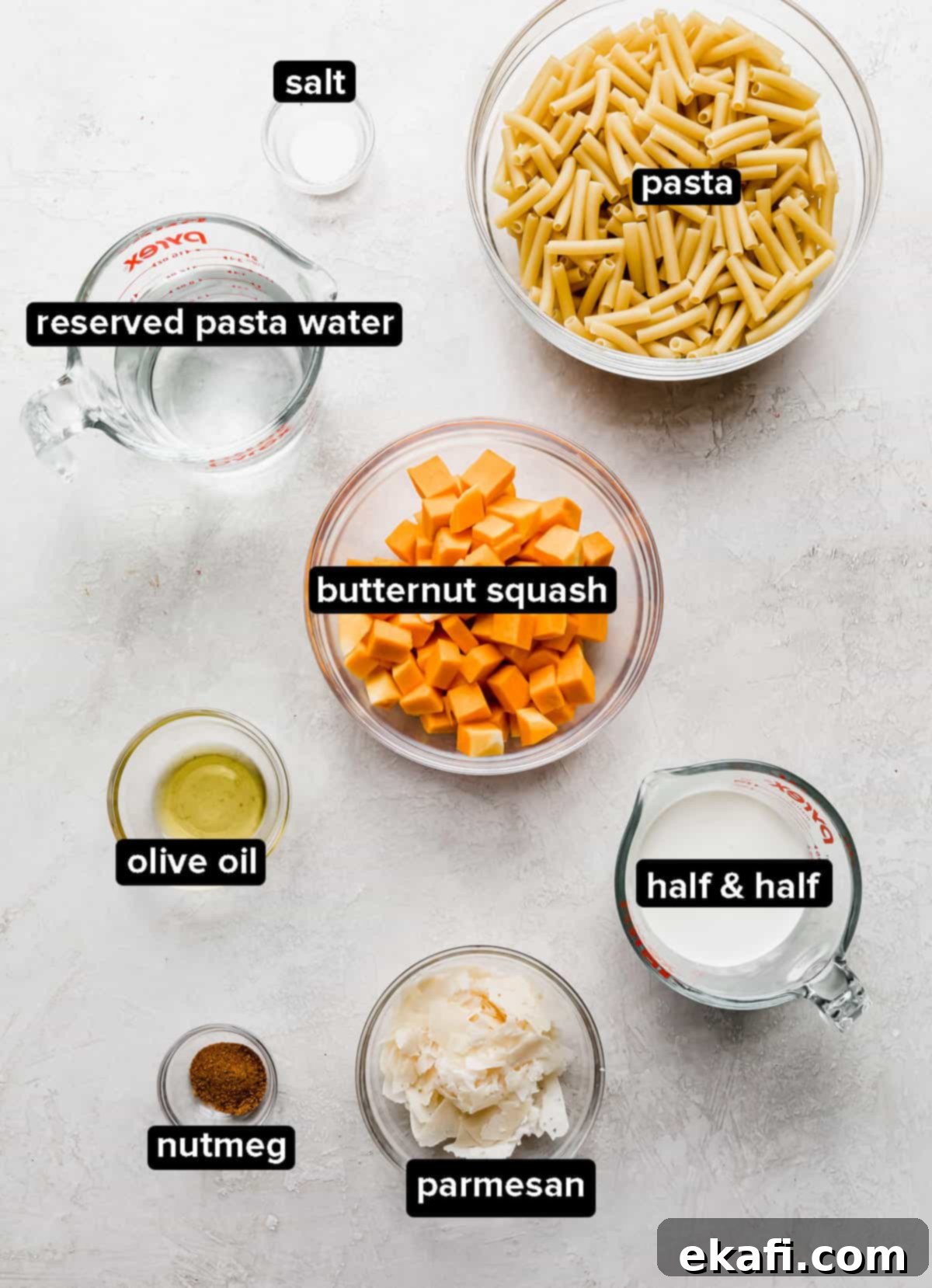
- Butternut Squash: The star of our show! Peeling and cubing the butternut squash before roasting is crucial. Roasting not only cooks the squash to a tender, puree-ready consistency but also caramelizes its natural sugars, intensifying its sweet and nutty flavor. This depth of flavor is what makes the sauce truly exceptional.
- Half & Half: This ingredient provides the perfect balance of richness without being overly heavy. It yields a beautifully creamy texture for your sauce. For an even more luxurious, indulgent dish, feel free to substitute with heavy cream. If you prefer a slightly lighter sauce, milk can be used, though it will result in a thinner consistency. Having made this sauce with both half & half and heavy cream, I find the difference in taste to be minimal, so opting for half & half is a great way to enjoy the creaminess with fewer calories.
- Reserved Pasta Water: This often-overlooked ingredient is a secret weapon in many pasta dishes. The starchy water left over from cooking your pasta is essential for achieving the perfect sauce consistency. It helps to emulsify the sauce, allowing it to cling beautifully to the noodles and creating a smoother, silkier finish. Be sure to reserve at least two cups; you can always add more or less depending on your desired thickness.
- Ground Nutmeg: Don’t skip this! Nutmeg is truly the secret ingredient that elevates this pasta from good to absolutely divine. Its warm, sweet, and slightly spicy notes perfectly complement the earthy sweetness of the butternut squash and the richness of the cream, imparting those delightful autumn vibes to the entire dish.
- Parmesan Cheese: Freshly grated Parmesan cheese adds a vital layer of savory, salty, and umami flavor. It melts into the sauce, contributing to its creamy texture and providing a sharp, cheesy element that balances the sweetness of the squash. For the best results, always opt for freshly grated over pre-shredded or powdered varieties.
- Olive Oil: Used for roasting the squash, it helps to achieve that lovely caramelization and adds a subtle fruity note.
- Salt & Pepper: Essential for seasoning the squash during roasting and later for adjusting the final flavor of the sauce. Kosher salt is preferred for its larger grain and less intense salty flavor per volume, allowing for better control.
- Pasta of Your Choice: While the recipe calls for “noodles of your choice,” medium-sized pasta shapes like penne, ziti, rigatoni, or even fettuccine work exceptionally well, as their surfaces or ridges help capture the thick, creamy sauce.
Step-by-Step Instructions for Creamy Butternut Squash Pasta
Follow these easy steps to create a rich and satisfying butternut squash pasta that will impress even the toughest critics:
- Roast the Butternut Squash: Begin by preheating your oven to 425°F (220°C). Peel the butternut squash and carefully cut it into approximately ½-inch cubes. Spread the cubed squash evenly on a baking sheet. Drizzle a generous amount of olive oil over the squash, then toss gently to ensure each piece is lightly coated. Roast in the preheated oven for about 25 minutes, or until the squash is fork-tender and slightly caramelized. The roasting process is crucial for developing its deep, sweet flavor.
- Cook the Pasta Noodles: While the squash is roasting, bring a large pot of water to a rolling boil. Once boiling vigorously, add a tablespoon of kosher salt to the water – this seasons the pasta from within and enhances the overall flavor of the dish. Add your chosen pasta noodles and cook according to package directions until they are perfectly al dente. “Al dente” means “to the tooth,” referring to pasta that is cooked through but still firm when bitten.
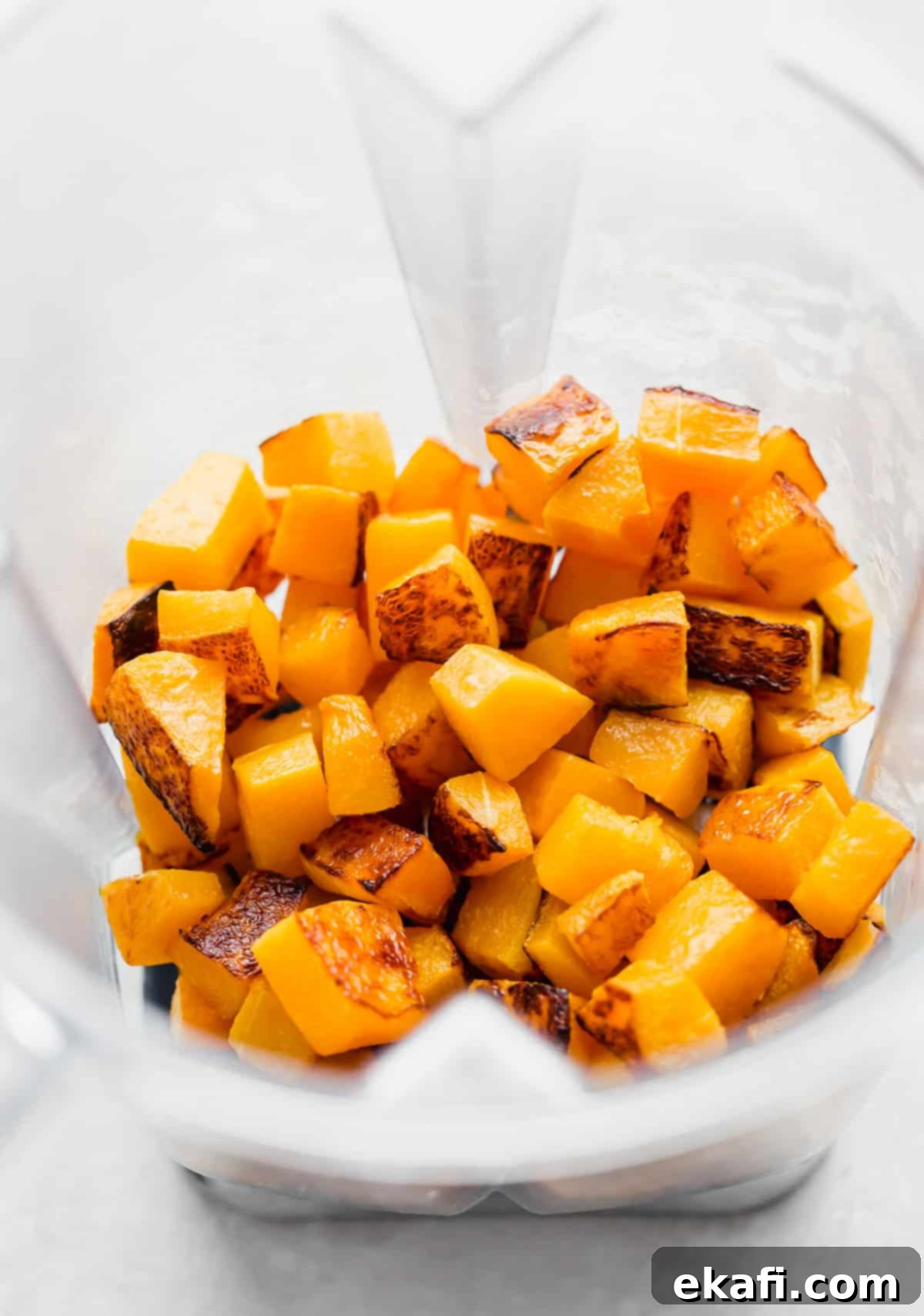
- Drain Pasta and Reserve Water: Before fully draining the pasta, ladle out at least 2 cups of the starchy pasta water into a heatproof mug or bowl. This water is critical for adjusting the sauce’s consistency later. Once the water is reserved, drain the cooked noodles thoroughly and return them to the large pot they were cooked in.
- Prepare the Butternut Squash Pasta Sauce: Carefully transfer the roasted butternut squash from the baking sheet into a food processor or a high-speed blender. Add the half & half (or heavy cream), ground nutmeg, kosher salt, and freshly grated Parmesan cheese. Begin blending, gradually adding about 1 to 1¼ cups of the reserved pasta water until the sauce is completely smooth and creamy. The amount of pasta water needed can vary, so start with less and add more if the sauce appears too thick.
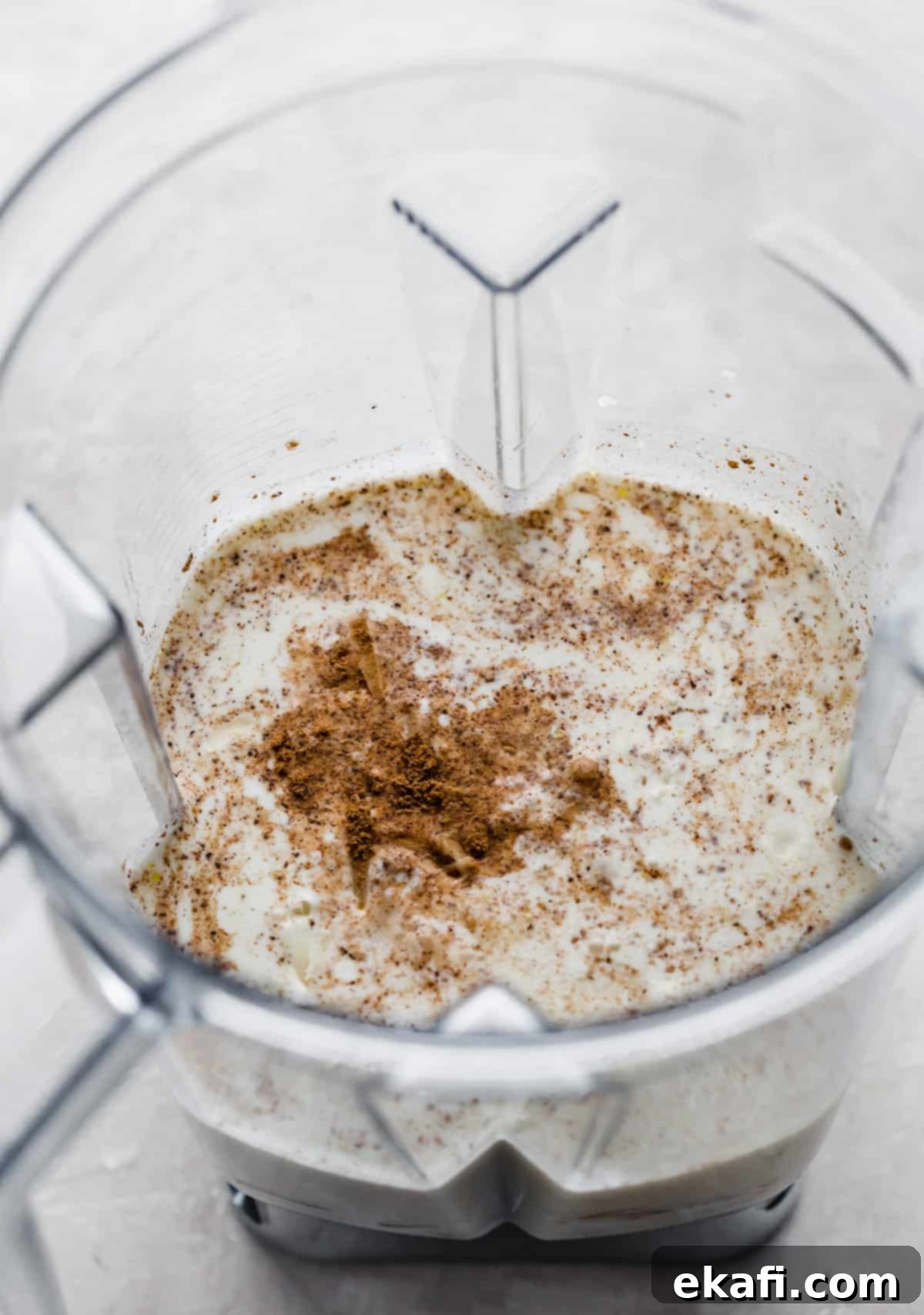
- Combine and Serve: Pour the freshly blended butternut squash pasta sauce over the drained noodles in the large pot. Toss vigorously to ensure every strand and piece of pasta is thoroughly coated in the luxurious sauce. Taste and season with additional salt and freshly ground black pepper as needed. Serve immediately, perhaps with an extra sprinkle of Parmesan and a few fresh herbs for garnish. Enjoy your homemade, comforting, and nutrient-packed meal!
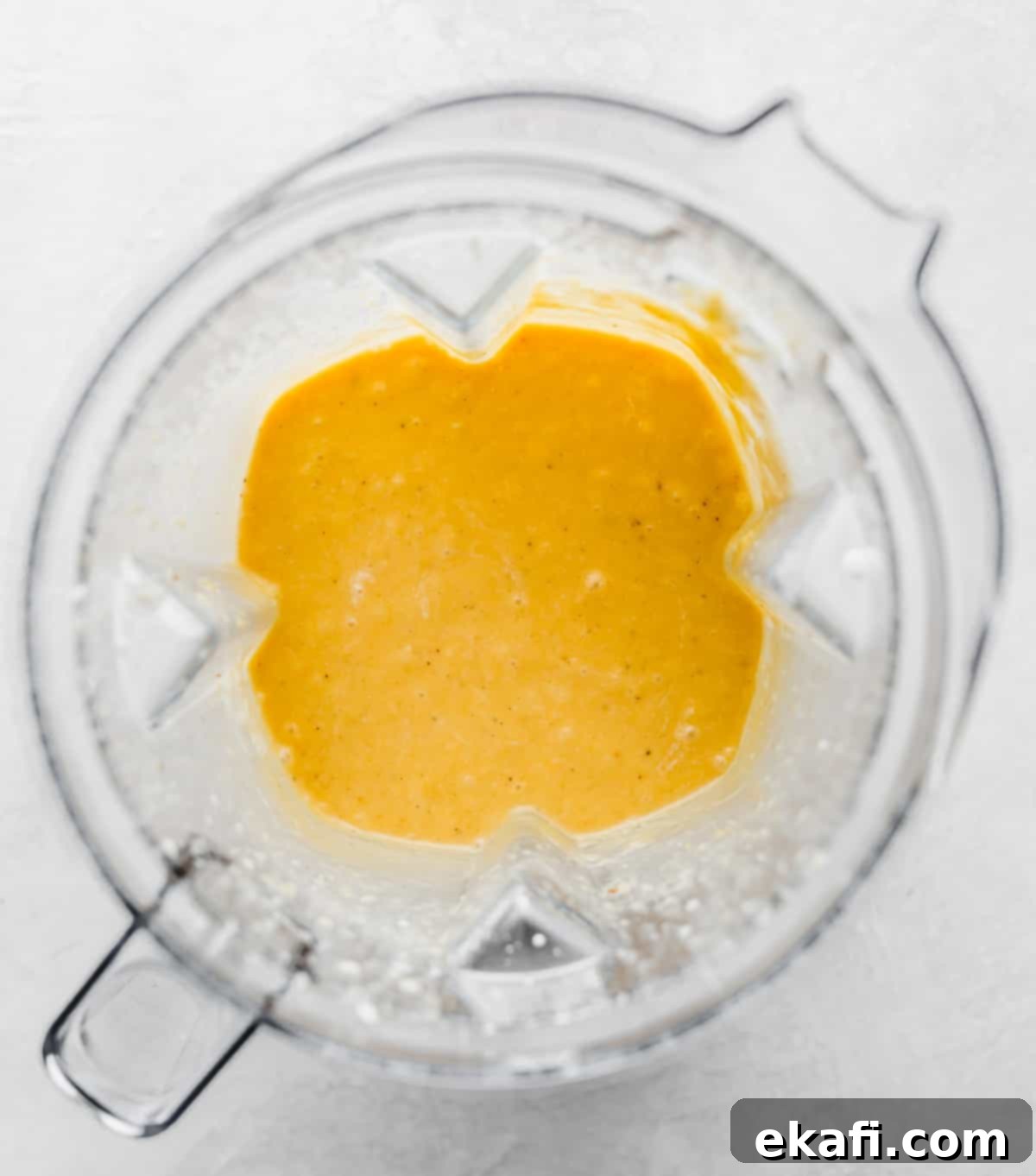
Expert Tips for the Best Butternut Squash Pasta
Achieving the perfect creamy butternut squash pasta is simple with these additional tips:
- Salt Usage: If you don’t have kosher salt, you can certainly use regular table salt. However, remember that table salt has finer grains and is denser, meaning you’ll need to reduce the amount by about half to achieve the same level of saltiness as kosher salt. Always taste and adjust!
- Adjusting Sauce Consistency: The pasta sauce will naturally thicken as it cools and after being tossed with the noodles. If you find the sauce is too thick for your liking after combining it with the pasta, simply add a splash or two of the reserved pasta water to the pan. Stir gently until you reach your desired consistency. The starch in the water will help the sauce emulsify beautifully.
- Parmesan Quality Matters: While you don’t *need* freshly grated Parmesan cheese, it undeniably makes a significant difference. Pre-grated Parmesan (from a bag) is fine, but avoid the Kraft-style powdered Parmesan from plastic bottles. It lacks the freshness, sharpness, and complex flavor that a good quality, freshly grated Parmesan brings to the dish. The flavor contribution is worth the extra minute of grating!
- Choosing Your Pasta Shape: Medium-sized pasta shapes with crevices or ridges, such as penne, rigatoni, ziti, or cavatappi, are excellent choices as they effectively hold onto the thick, creamy sauce. Longer strands like fettuccine or linguine also work well for a different mouthfeel.
- Enhance Flavor with Aromatics: For an extra layer of flavor, consider sautéing a minced garlic clove and/or a finely chopped shallot in a little olive oil before adding the roasted squash to the blender. This step can add a wonderful aromatic depth to your sauce.
- Don’t Overcook the Squash: While you want the squash to be fork-tender for easy blending, avoid over-roasting it to the point of being burnt or completely mushy. This can lead to a slightly bitter taste in your sauce.
- Garnish for Freshness: A sprinkle of fresh herbs like chopped parsley, sage, or chives can add a burst of freshness and visual appeal to your finished dish.
Make Ahead, Storing, and Freezing Your Butternut Squash Pasta
This recipe is excellent for meal prepping and managing leftovers, with a few important considerations:
- Make Ahead: The butternut squash pasta sauce can be prepared ahead of time and stored in an airtight container in the refrigerator for up to 3 days. When ready to serve, gently reheat the sauce, adding a splash of milk or reserved pasta water to restore its creamy consistency if needed. Cook fresh pasta and combine.
- Storing Leftovers: Any leftover combined pasta and sauce should be stored in an airtight container in the fridge for up to 3 days. Reheat gently on the stovetop or in the microwave, again, adding a little liquid (water or milk) if the sauce has thickened too much.
- Freezing the Sauce: For longer storage, you’ll want to freeze the butternut squash puree *before* adding the dairy (half & half or heavy cream). Dairy products, especially those with lower fat content, can easily separate and become grainy or watery when frozen and then thawed. To freeze, simply blend the roasted butternut squash with salt, nutmeg, and some pasta water until smooth. Portion this dairy-free puree into airtight containers or freezer-safe bags and freeze for up to 6 months. When you’re ready to use it, thaw the puree overnight in the refrigerator. Then, proceed with the recipe from step 4, adding the half & half and Parmesan cheese to the thawed puree before combining with cooked pasta. This method ensures your sauce remains perfectly creamy after freezing.
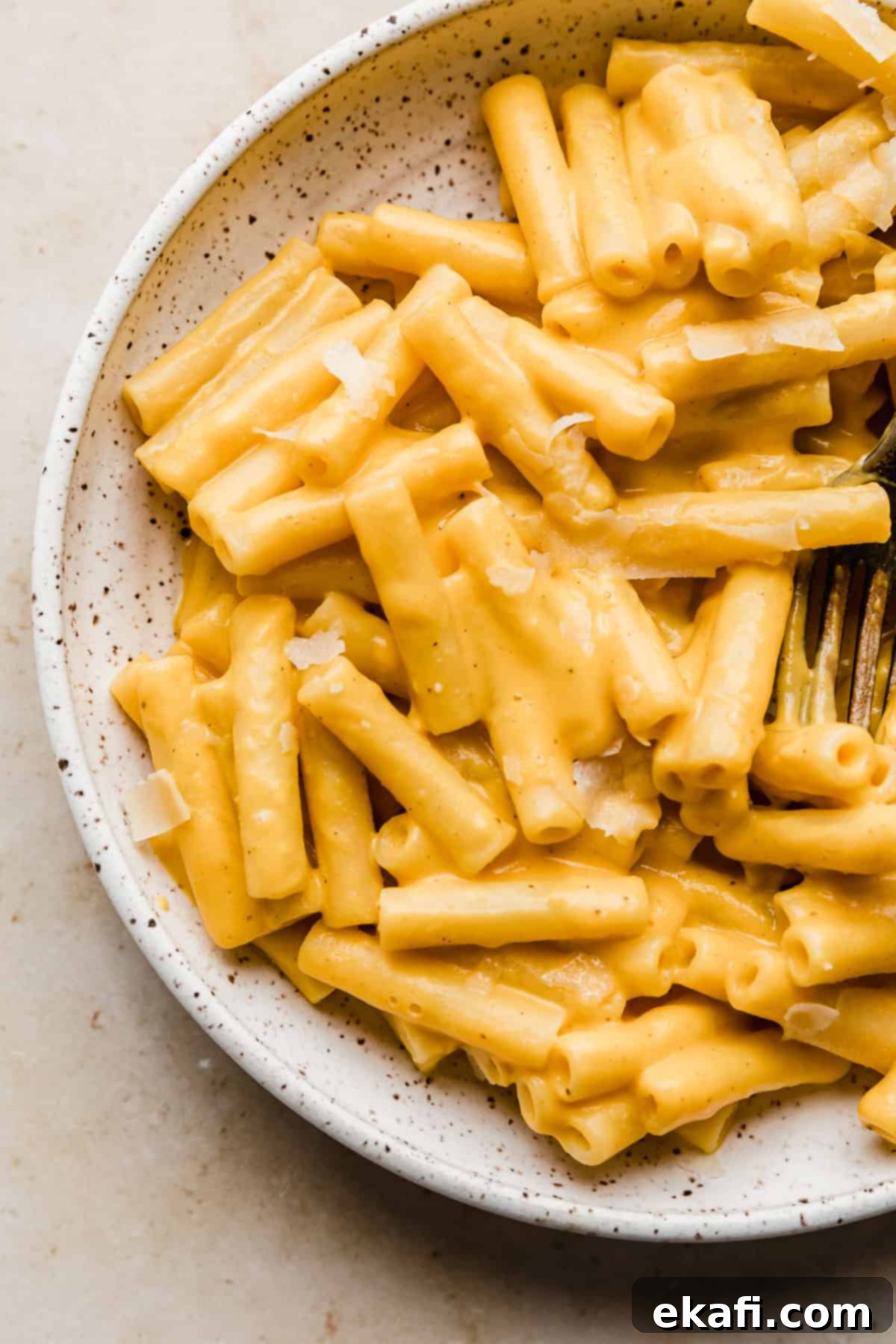
Frequently Asked Questions About Butternut Squash Pasta
Yes, sweet potato can be a suitable substitute for butternut squash in this pasta recipe. They have similar sweet and earthy flavor profiles. However, keep in mind that sweet potatoes generally have a lower water content than butternut squash, so the consistency of your sauce might be slightly thicker. You may need to add a bit more reserved pasta water or a touch more dairy to achieve the desired creaminess.
Any other winter squash variety would typically work well as a substitute for butternut squash. Common winter squashes include acorn squash, delicata squash, and even sugar pumpkin. These will all roast beautifully and provide a creamy base. However, I would not recommend substituting spaghetti squash, as its stringy texture is quite different and won’t blend into a smooth sauce.
While butternut squash isn’t considered a strict low-carb vegetable like leafy greens, it can be incorporated into a less strict ketogenic diet in moderation. The keto diet emphasizes high-fat and low-carb foods. Winter squashes, including butternut squash, contain more carbohydrates than many other vegetables. A cup of cooked butternut squash has approximately 15 net carbs. In comparison, acorn squash is higher in carbs and generally avoided on keto. For strict keto followers, butternut squash might be too carb-heavy, but for those with a more flexible approach, it can be enjoyed occasionally as part of a balanced meal.
Absolutely! This butternut squash pasta recipe offers a wonderful way to boost the nutritional value of your meal. Butternut squash is packed with essential minerals and nutrients, including a significant amount of potassium (beneficial for blood pressure regulation), vitamin E, and vitamin C. Incorporating this vegetable into a creamy pasta dish adds a healthy dose of fiber and antioxidants, making it a delicious and nourishing option for your family.
Yes, with a few simple modifications! To make this recipe vegan or dairy-free, substitute the half & half with a plant-based cream alternative such as full-fat coconut milk (for a richer flavor), cashew cream, or a plain unsweetened plant-based milk (like almond or soy milk for a lighter sauce). For the Parmesan cheese, use a good quality dairy-free Parmesan alternative. The roasted butternut squash itself is naturally vegan.
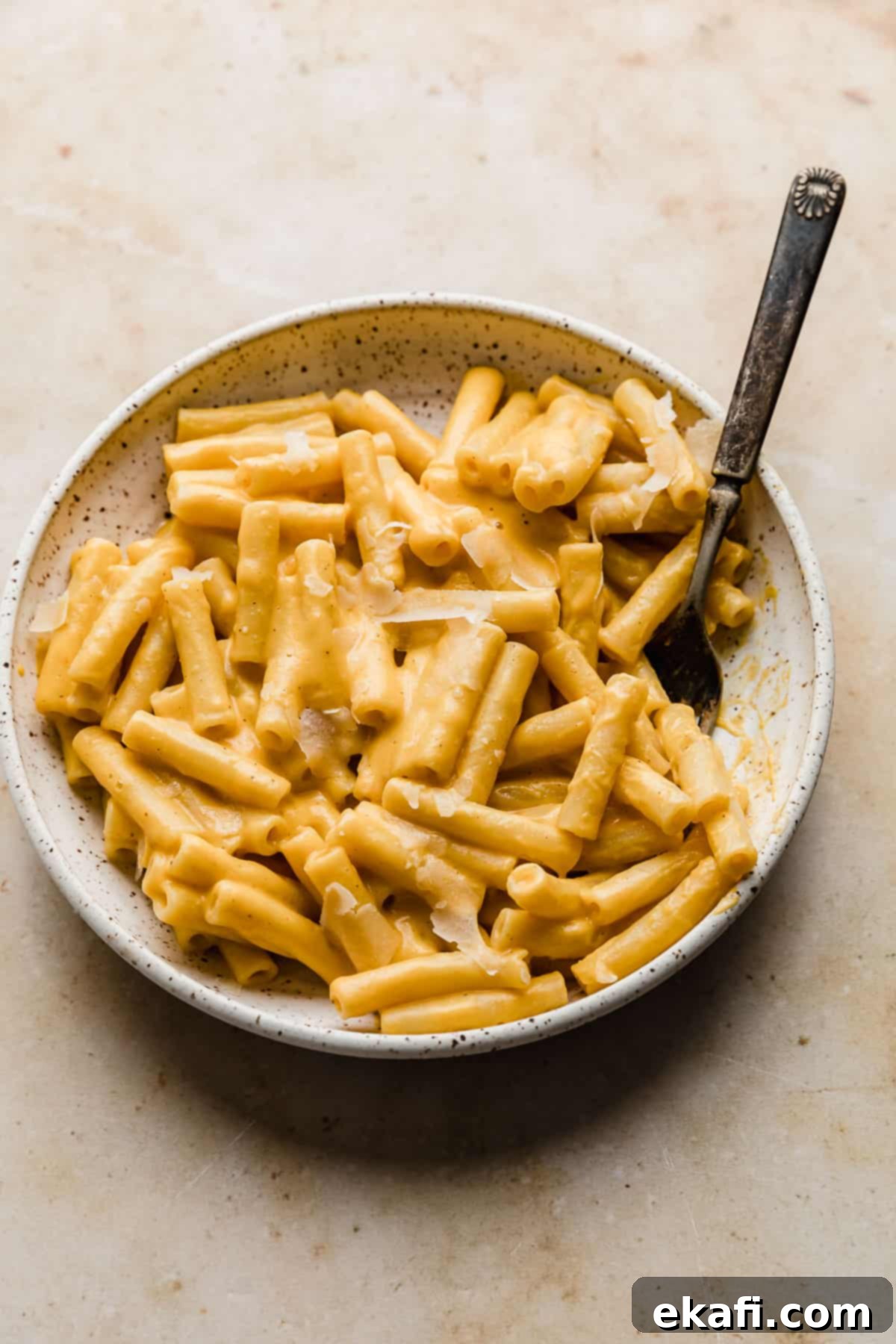
More Delightful Kid-Friendly Pasta Recipes
If your family enjoys this butternut squash pasta, be sure to explore these other fantastic kid-friendly pasta dishes:
- Bright & Zesty Lemon Pasta Recipe
- Flavorful Pesto Pasta with Zucchini and Ricotta
- Nutrient-Rich Kale Pesto Pasta
- Fun & Easy Pizza Casserole
This creamy butternut squash pasta is more than just a meal; it’s an experience. It brings together wholesome ingredients, incredible flavors, and simple preparation, making it an ideal choice for any occasion. Whether you’re looking to feed a family, impress guests, or simply enjoy a comforting bowl of pasta, this recipe delivers every time. We hope you cherish making and savoring this delightful dish as much as we do!
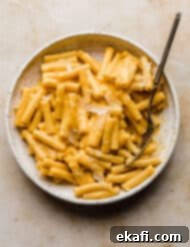
Print
SaveSaved!
Review
Butternut Squash Pasta
Ingredients
- 2 heaping cups butternut squash – peeled and cut into 1/2″ cubes
- 2 teaspoons olive oil
- 3/4 cup half & half – for a richer sauce, use heavy cream; for lighter, use milk.
- 1/2 teaspoon ground nutmeg
- 1 teaspoon kosher salt
- 2/3 cup freshly grated parmesan cheese
- 1 1/4 cup reserved pasta water – save at least 2 cups, you may need more or less depending on desired consistency
- 1 lb pasta of your choice – penne, ziti, or rigatoni work well
- Freshly ground black pepper – to taste
Instructions
-
Preheat Oven: Preheat your oven to 425°F (220°C).
-
Roast Squash: Place the peeled and cubed butternut squash on a baking sheet. Drizzle with olive oil and toss to coat evenly.
-
Bake Squash: Roast the squash in the preheated oven for 25 minutes, or until it is tender when pierced with a fork and lightly caramelized.
-
Cook Pasta: While the squash finishes roasting, bring a large pot of water to a boil. Add a tablespoon of salt, then add your chosen pasta noodles. Cook according to package directions until al dente.
-
Drain & Reserve Water: Drain the cooked noodles, making sure to reserve at least 2 cups of the starchy pasta water. Return the drained noodles to the large pot. You’ll use the reserved water to adjust the sauce consistency later.
-
Make Sauce: Carefully transfer the roasted butternut squash to a food processor or blender. Add the half & half, ground nutmeg, salt, freshly grated Parmesan cheese, and 1 to 1¼ cups of the reserved pasta water. Blend until the sauce is completely smooth and creamy.
-
Combine & Serve: Pour the blended butternut squash sauce over the noodles in the pot. Toss well to ensure the pasta is fully coated. If the sauce is too thick, add a few tablespoons of the remaining reserved pasta water until it reaches your desired consistency. Taste and season with additional salt and freshly ground black pepper as needed. Serve immediately and enjoy!
Notes
Make Ahead, Storing, and Freezing: Store the combined butternut squash pasta leftovers in an airtight container in the fridge for up to 3 days.
If you plan to freeze, blend the roasted butternut squash with salt, nutmeg, and pasta water *before* adding the half & half or heavy cream. Freeze this dairy-free puree in an airtight container for up to 6 months. Thaw overnight in the fridge, then continue the recipe from the blending step, adding your dairy and Parmesan. This prevents the sauce from separating during freezing and thawing.
I’ve personally made this sauce using both half & half and heavy cream. In my experience, there isn’t a significant taste difference, so opting for half & half allows for a slightly lighter dish without compromising on creaminess.
Nutrition
This recipe was originally published in October 2019. It was republished on Jan. 11, 2022, to include additional information and photos, and further updated for enhanced clarity and SEO in [Current Month, Year].
